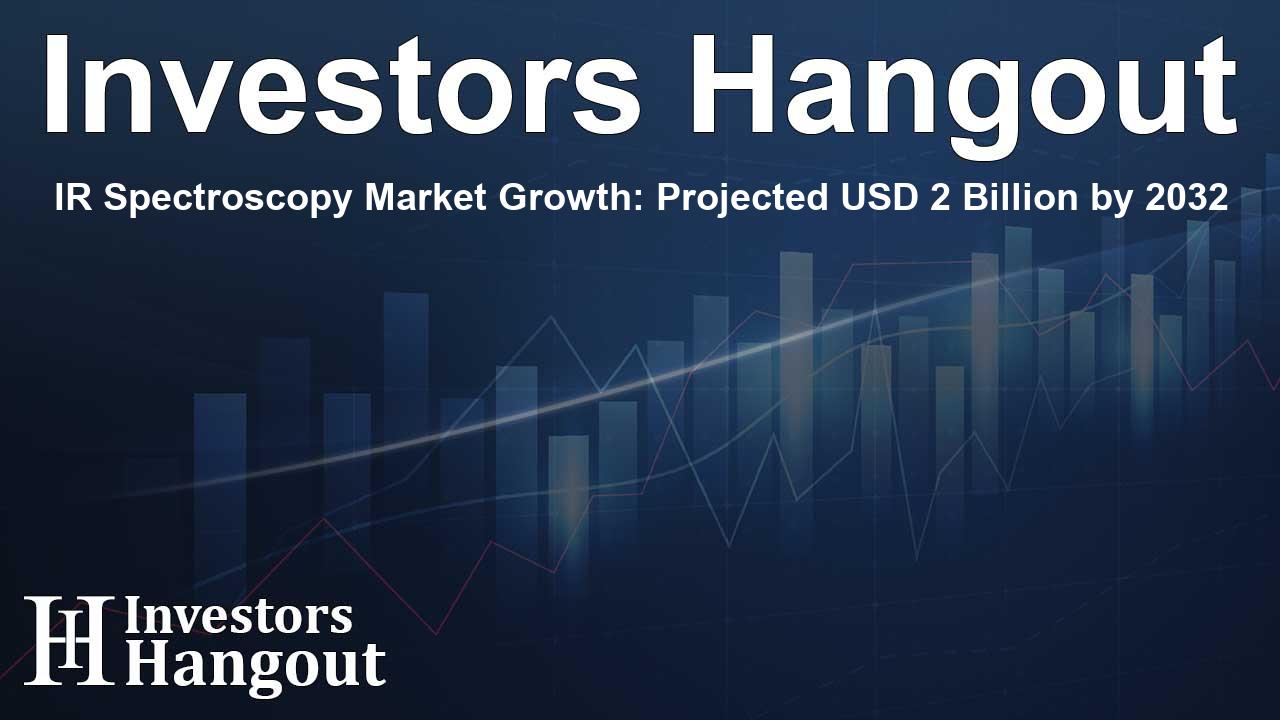IR Spectroscopy Market Growth: Projected USD 2 Billion by 2032

IR Spectroscopy Market Insights and Future Growth
Growing trends in technology and application expansion are driving significant changes in the IR spectroscopy market, which was valued at USD 1.3 billion recently. This market is projected to surpass USD 2 billion by the end of this decade. One of the primary contributors to this growth is the miniaturization and portability of IR spectrometers, enabling real-time analysis across a diversity of sectors.
Advancements in IR Spectroscopy Technology
The evolution of portable IR spectrometers has made these devices increasingly essential for rapid assessments in critical areas such as environmental monitoring, food safety, and forensic science. As industries seek more efficient methods for on-site analysis, the demand for handheld devices is expected to soar.
Applications in the Pharmaceutical Industry
In the pharmaceutical sector, the adoption of IR spectroscopy is on the rise due to its vital functions in drug development and regulatory compliance. Utilizing this technique allows companies to conduct non-destructive analyses of chemical compositions throughout the various stages of drug formulation. Notably, the ability to identify molecular structures and verify compound purity enhances the drug discovery process significantly.
Market Share by Technology
Among the different technology segments, Fourier Transform Infrared Spectroscopy (FTIR) accounted for over 30% of the market share. This advanced technique is preferred for its ability to provide detailed molecular insights using broad-spectrum absorbance readings, making it far more versatile than traditional methods.
Emergence of Portable Devices
The segment for portable IR spectroscopy is set to experience notable growth, with an estimated compound annual growth rate (CAGR) exceeding 9% between the forthcoming years. Portable instruments empower users with field-deployable options that deliver immediate results—transforming approaches to environmental assessments, food safety regulations, and security measures.
Regional Market Dynamics
North America has taken the lead in the global IR spectroscopy landscape, claiming over 35% of the overall market share. This dominance is reflective of a robust pharmaceutical industry and a strong commitment to scientific research and development. The influence of the U.S. is particularly marked, with its extensive network of pharmaceutical firms and research institutions relying heavily on IR spectroscopy.
Key Players Driving Growth
Prominent companies such as Thermo Fisher Scientific, PerkinElmer, Bruker, Shimadzu, Agilent Technologies, Jasco International, and Horiba are at the forefront of advancing IR spectroscopy technology. Their contributions are pivotal in shaping the future landscape of this market.
Market Segmentation Overview
This market examination includes comprehensive estimates and forecasts from the following categories:
Technology Categories
- Dispersive IR spectroscopy
- Fourier Transform Infrared (FTIR) spectroscopy
- Attenuated Total Reflectance (ATR) spectroscopy
- Others
Types of Spectroscopy
- Near-Infrared (NIR) spectroscopy
- Mid-Infrared (MIR) spectroscopy
- Far-Infrared (FIR) spectroscopy
Product Categories
- Benchtop IR spectroscopy
- Portable IR spectroscopy
- Microscopy IR spectroscopy
- Hyphenated IR spectroscopy
End-Use Industries
- Healthcare & Pharmaceuticals
- Food and Beverage
- Chemical
- Environmental
- Biomedical Research & Biomaterials
- Others
About Global Market Insights
Global Market Insights Inc., with its headquarters in Delaware, is a renowned name in the realm of market research. They specialize in providing both syndicated and custom research reports across various sectors, including chemicals, advanced materials, and biotechnology. Their strategic insights and market data are essential for driving smart business decisions.
Frequently Asked Questions
1. What is the projected growth of the IR spectroscopy market?
The IR spectroscopy market is projected to exceed USD 2 billion by the end of this decade.
2. Why is IR spectroscopy important in the pharmaceutical industry?
IR spectroscopy is vital for drug development, providing non-destructive analysis crucial for ensuring drug purity and efficacy.
3. What technology segment dominates the IR spectroscopy market?
Fourier Transform Infrared (FTIR) spectroscopy holds over 30% of the market share.
4. Which region leads the IR spectroscopy market?
North America leads the IR spectroscopy market, largely due to its robust pharmaceutical industry and technological advancements.
5. Who are the major players in the IR spectroscopy market?
Key players include Thermo Fisher Scientific, PerkinElmer, Bruker, Shimadzu, and Agilent Technologies, among others.
About The Author
Contact Henry Turner privately here. Or send an email with ATTN: Henry Turner as the subject to contact@investorshangout.com.
About Investors Hangout
Investors Hangout is a leading online stock forum for financial discussion and learning, offering a wide range of free tools and resources. It draws in traders of all levels, who exchange market knowledge, investigate trading tactics, and keep an eye on industry developments in real time. Featuring financial articles, stock message boards, quotes, charts, company profiles, and live news updates. Through cooperative learning and a wealth of informational resources, it helps users from novices creating their first portfolios to experts honing their techniques. Join Investors Hangout today: https://investorshangout.com/
The content of this article is based on factual, publicly available information and does not represent legal, financial, or investment advice. Investors Hangout does not offer financial advice, and the author is not a licensed financial advisor. Consult a qualified advisor before making any financial or investment decisions based on this article. This article should not be considered advice to purchase, sell, or hold any securities or other investments. If any of the material provided here is inaccurate, please contact us for corrections.
